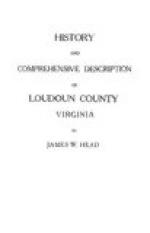Small quantities of silver ore are discovered from time to time; but the leads have never been extensively worked and many of the richest veins are still untouched.
Deposits of copper in the schists have long excited interest and led to mining operations. The amount of ore, however, appears not to have justified any considerable work.
Near the base of the Catoctin Mountain, where it is first approached by Goose Creek, marble of an excellent quality is found but has been little worked. Among the varieties at the quarry are included pure white, white and pink, blue and white, white and green, serpentinized and chloritic serpentinized marble. These marbles are of great beauty and susceptible of a good polish. The calcareous bed here is about fifty feet thick and reaches southward for three miles with increasing thickness. At its southern end it is not entirely metamorphosed into marble, but retains its original character of fine blue limestone. Northward along this range the thickness of the marble constantly diminishes and rarely exceeds ten feet. Sometimes there are two beds, sometimes only one. At Taylorstown, just south of the Potomac, the bed is about three feet thick; on the north side of the Potomac about four or five feet. Here, as elsewhere, the beds of marble are inclosed in a bluish green micaceous schist, which has been thoroughly transformed by mechanical pressure.
In the vicinity of Leesburg and north of that town, and between the Catoctin Mountain and the Potomac River, the conglomerate limestone or brecciated marble is found in abundance, associated with red shale. It is a calcareous rock, apparently formed in part of pebbles cemented together and, when burned, produces an inferior lime. It is commonly known as Potomac marble. Of this variegated marble were formed the beautiful columns in the old Representatives’ chamber of the Capitol at Washington. The soil in which this rock occurs is extremely productive and valuable.
The exhibition at the World’s Fair, at New Orleans, of the following specimens of Loudoun minerals claimed much interest from visiting mineraloguists:
1. Specular Iron Ore, from near Leesburg, said to be in quantity. From Professor Fontaine.
2. Chalcopyrite, from near Leesburg, said to be a promising vein. From Professor Fontaine.
The following were contributed by the “Eagle Mining Company,” of Leesburg; F. A. Wise, general manager:
1. Carbonate of Copper, from vein 3’ wide, developed to 25’ deep. Assays by Oxford Copper Company of New York give 51 per cent of copper and 27 ounces of silver per ton.
2. Sulphuret of Copper, from vein 10” wide, developed to 50’ deep. Assays by Oxford Copper Company of New York give 12-1/2 per cent of copper.
3. Iron Ore, from vein 4’ wide and 50’ deep. Yields 55 per cent metallic iron by assay of W. P. Lawver, of U. S. Mint.




